注意
单击此处下载完整的示例代码
多语言数据的强制对齐¶
本教程介绍如何将非英语语言的转录与语音对齐。
对齐非英语(标准化)成绩单的过程与对齐
英语(标准化)成绩单,英语的过程在 CTC 强制对齐教程中详细介绍。
在本教程中,我们使用 TorchAudio 的高级 APItorchaudio.pipelines.Wav2Vec2FABundle,它将预训练的
model、tokenizer 和 aligner 来执行强制对齐,以更少的代码执行强制对齐。
import torch
import torchaudio
print(torch.__version__)
print(torchaudio.__version__)
device = torch.device("cuda" if torch.cuda.is_available() else "cpu")
print(device)
2.4.0
2.4.0
cuda
from typing import List
import IPython
import matplotlib.pyplot as plt
创建管道¶
首先,我们实例化模型和前/后处理管道。
下图说明了对齐过程。

波形被传递给声学模型,该模型生成 代币的概率分布。 转录文本将传递给 tokenizer,后者将转录文本转换为 标记序列。 Aligner 从声学模型和分词器中获取结果并生成 每个令牌的时间戳。
注意
此过程期望输入转录已规范化。 规范化过程,涉及非英语的罗马化 languages 与语言相关,因此本教程不涉及 但我们会仔细研究它。
声学模型和分词器必须使用同一组令牌。
为了便于创建匹配的处理器,Wav2Vec2FABundle合伙人 A
预先训练的声学模型和分词器。torchaudio.pipelines.MMS_FA就是这样一个例子。
以下代码实例化了一个预先训练的声学模型,即 tokenizer 它使用与模型相同的 tokens 集和 aligner。
注意
实例化的模型MMS_FA的get_model()method 默认包括 Token 的 Feature 维度。
您可以通过传递 .<star>with_star=False
的声学模型MMS_FA是
作为研究项目 Scaling Speech Technology to 1,000+ Languages 的一部分创建并开源。
它使用来自 1100+ 种语言的 23,000 小时音频进行了训练。
分词器只是将规范化字符映射到整数。 您可以按如下方式检查映射;
print(bundle.get_dict())
{'-': 0, 'a': 1, 'i': 2, 'e': 3, 'n': 4, 'o': 5, 'u': 6, 't': 7, 's': 8, 'r': 9, 'm': 10, 'k': 11, 'l': 12, 'd': 13, 'g': 14, 'h': 15, 'y': 16, 'b': 17, 'p': 18, 'w': 19, 'c': 20, 'v': 21, 'j': 22, 'z': 23, 'f': 24, "'": 25, 'q': 26, 'x': 27, '*': 28}
矫正器内部使用torchaudio.functional.forced_align()和torchaudio.functional.merge_tokens()推断时间
Stamp 的标记。
底层机制的详细信息在 CTC 强制对齐 API 教程中介绍, 所以请参考它。
我们定义了一个实用程序函数,该函数执行强制对齐 上述模型,tokenizer 和 aligner。
def compute_alignments(waveform: torch.Tensor, transcript: List[str]):
with torch.inference_mode():
emission, _ = model(waveform.to(device))
token_spans = aligner(emission[0], tokenizer(transcript))
return emission, token_spans
我们还定义了用于绘制结果和预览的实用函数 音频片段。
# Compute average score weighted by the span length
def _score(spans):
return sum(s.score * len(s) for s in spans) / sum(len(s) for s in spans)
def plot_alignments(waveform, token_spans, emission, transcript, sample_rate=bundle.sample_rate):
ratio = waveform.size(1) / emission.size(1) / sample_rate
fig, axes = plt.subplots(2, 1)
axes[0].imshow(emission[0].detach().cpu().T, aspect="auto")
axes[0].set_title("Emission")
axes[0].set_xticks([])
axes[1].specgram(waveform[0], Fs=sample_rate)
for t_spans, chars in zip(token_spans, transcript):
t0, t1 = t_spans[0].start, t_spans[-1].end
axes[0].axvspan(t0 - 0.5, t1 - 0.5, facecolor="None", hatch="/", edgecolor="white")
axes[1].axvspan(ratio * t0, ratio * t1, facecolor="None", hatch="/", edgecolor="white")
axes[1].annotate(f"{_score(t_spans):.2f}", (ratio * t0, sample_rate * 0.51), annotation_clip=False)
for span, char in zip(t_spans, chars):
t0 = span.start * ratio
axes[1].annotate(char, (t0, sample_rate * 0.55), annotation_clip=False)
axes[1].set_xlabel("time [second]")
fig.tight_layout()
def preview_word(waveform, spans, num_frames, transcript, sample_rate=bundle.sample_rate):
ratio = waveform.size(1) / num_frames
x0 = int(ratio * spans[0].start)
x1 = int(ratio * spans[-1].end)
print(f"{transcript} ({_score(spans):.2f}): {x0 / sample_rate:.3f} - {x1 / sample_rate:.3f} sec")
segment = waveform[:, x0:x1]
return IPython.display.Audio(segment.numpy(), rate=sample_rate)
规范化转录本¶
必须事先对传递给管道的转录文本进行规范化。 规范化的确切过程取决于语言。
没有明确单词边界的语言 (如中文、日语和韩语)需要首先进行分段。 有专门的工具可以做到这一点,但假设我们已经进行了分段 抄本。
规范化的第一步是罗马化。Uroman 是一种工具 支持多种语言。
这是一个 BASH 命令,用于将输入文本文件罗马化并写入
使用 .uroman
$ echo "des événements d'actualité qui se sont produits durant l'année 1882" > text.txt
$ uroman/bin/uroman.pl < text.txt > text_romanized.txt
$ cat text_romanized.txt
Cette page concerne des evenements d'actualite qui se sont produits durant l'annee 1882
下一步是删除非字母和标点符号。 以下代码片段对罗马化的转录文本进行了规范化。
import re
def normalize_uroman(text):
text = text.lower()
text = text.replace("’", "'")
text = re.sub("([^a-z' ])", " ", text)
text = re.sub(' +', ' ', text)
return text.strip()
with open("text_romanized.txt", "r") as f:
for line in f:
text_normalized = normalize_uroman(line)
print(text_normalized)
在上述示例上运行脚本将生成以下内容。
cette page concerne des evenements d'actualite qui se sont produits durant l'annee
请注意,在此示例中,由于 “1882” 不是用 罗马音化的 ,
它在 normalization 步骤中删除。
为避免这种情况,需要将数字罗马化,但众所周知,这是一项非同艰的任务。uroman
将转录与语音对齐¶
现在,我们对多种语言执行强制对齐。
德语¶
text_raw = "aber seit ich bei ihnen das brot hole"
text_normalized = "aber seit ich bei ihnen das brot hole"
url = "https://download.pytorch.org/torchaudio/tutorial-assets/10349_8674_000087.flac"
waveform, sample_rate = torchaudio.load(
url, frame_offset=int(0.5 * bundle.sample_rate), num_frames=int(2.5 * bundle.sample_rate)
)
assert sample_rate == bundle.sample_rate
transcript = text_normalized.split()
tokens = tokenizer(transcript)
emission, token_spans = compute_alignments(waveform, transcript)
num_frames = emission.size(1)
plot_alignments(waveform, token_spans, emission, transcript)
print("Raw Transcript: ", text_raw)
print("Normalized Transcript: ", text_normalized)
IPython.display.Audio(waveform, rate=sample_rate)
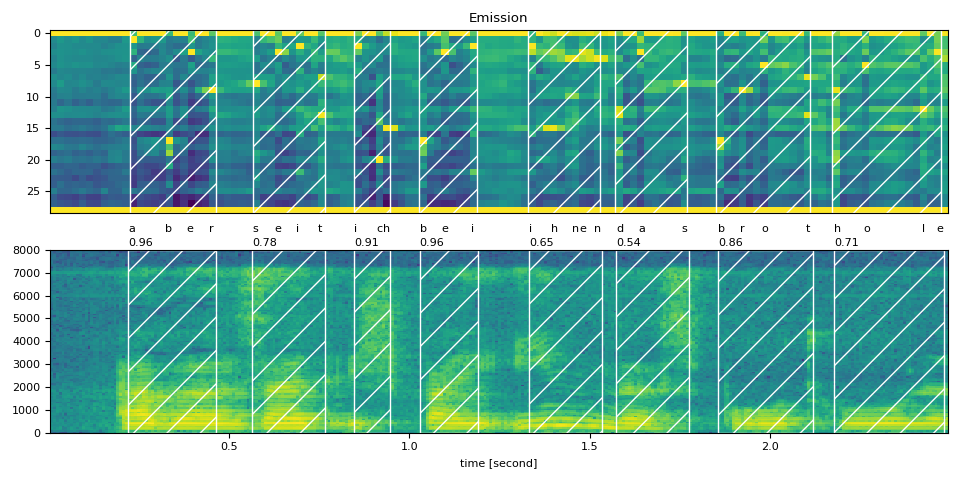
Raw Transcript: aber seit ich bei ihnen das brot hole
Normalized Transcript: aber seit ich bei ihnen das brot hole
preview_word(waveform, token_spans[0], num_frames, transcript[0])
aber (0.96): 0.222 - 0.464 sec
preview_word(waveform, token_spans[1], num_frames, transcript[1])
seit (0.78): 0.565 - 0.766 sec
preview_word(waveform, token_spans[2], num_frames, transcript[2])
ich (0.91): 0.847 - 0.948 sec
preview_word(waveform, token_spans[3], num_frames, transcript[3])
bei (0.96): 1.028 - 1.190 sec
preview_word(waveform, token_spans[4], num_frames, transcript[4])
ihnen (0.65): 1.331 - 1.532 sec
preview_word(waveform, token_spans[5], num_frames, transcript[5])
das (0.54): 1.573 - 1.774 sec
preview_word(waveform, token_spans[6], num_frames, transcript[6])
brot (0.86): 1.855 - 2.117 sec
preview_word(waveform, token_spans[7], num_frames, transcript[7])
hole (0.71): 2.177 - 2.480 sec
中文¶
中文是一种基于字符的语言,没有明确的词级 原始书面形式的分词化(用空格分隔)。为了 获取单词级别对齐,您需要首先对成绩单进行分词 在单词级别使用单词分词器,例如“Stanford Tokenizer 的 Tokenizer”。 但是,如果您只想要字符级对齐,则不需要这样做。
text_raw = "关 服务 高端 产品 仍 处于 供不应求 的 局面"
text_normalized = "guan fuwu gaoduan chanpin reng chuyu gongbuyingqiu de jumian"
assert sample_rate == bundle.sample_rate
transcript = text_normalized.split()
emission, token_spans = compute_alignments(waveform, transcript)
num_frames = emission.size(1)
plot_alignments(waveform, token_spans, emission, transcript)
print("Raw Transcript: ", text_raw)
print("Normalized Transcript: ", text_normalized)
IPython.display.Audio(waveform, rate=sample_rate)
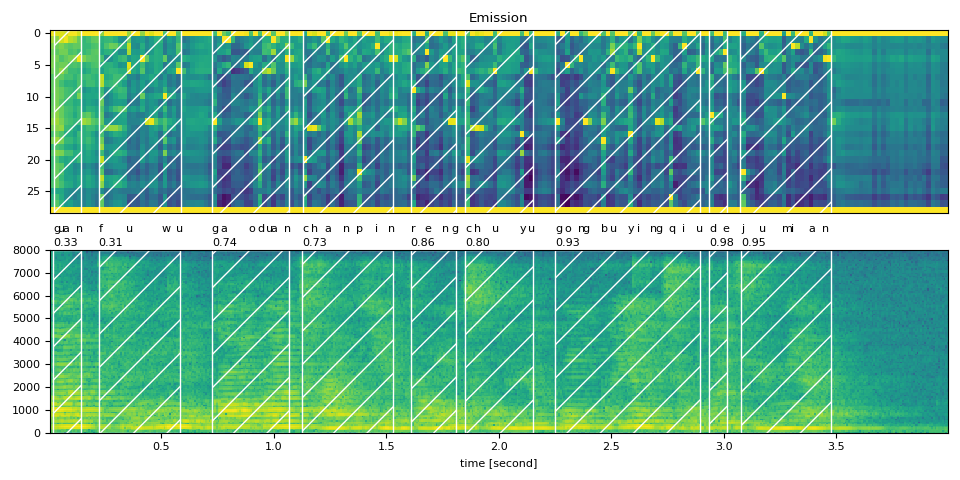
Raw Transcript: 关 服务 高端 产品 仍 处于 供不应求 的 局面
Normalized Transcript: guan fuwu gaoduan chanpin reng chuyu gongbuyingqiu de jumian
preview_word(waveform, token_spans[0], num_frames, transcript[0])
guan (0.33): 0.020 - 0.141 sec
preview_word(waveform, token_spans[1], num_frames, transcript[1])
fuwu (0.31): 0.221 - 0.583 sec
preview_word(waveform, token_spans[2], num_frames, transcript[2])
gaoduan (0.74): 0.724 - 1.065 sec
preview_word(waveform, token_spans[3], num_frames, transcript[3])
chanpin (0.73): 1.126 - 1.528 sec
preview_word(waveform, token_spans[4], num_frames, transcript[4])
reng (0.86): 1.608 - 1.809 sec
preview_word(waveform, token_spans[5], num_frames, transcript[5])
chuyu (0.80): 1.849 - 2.151 sec
preview_word(waveform, token_spans[6], num_frames, transcript[6])
gongbuyingqiu (0.93): 2.251 - 2.894 sec
preview_word(waveform, token_spans[7], num_frames, transcript[7])
de (0.98): 2.935 - 3.015 sec
preview_word(waveform, token_spans[8], num_frames, transcript[8])
jumian (0.95): 3.075 - 3.477 sec
波兰语¶
text_raw = "wtedy ujrzałem na jego brzuchu okrągłą czarną ranę"
text_normalized = "wtedy ujrzalem na jego brzuchu okragla czarna rane"
url = "https://download.pytorch.org/torchaudio/tutorial-assets/5090_1447_000088.flac"
waveform, sample_rate = torchaudio.load(url, num_frames=int(4.5 * bundle.sample_rate))
assert sample_rate == bundle.sample_rate
transcript = text_normalized.split()
emission, token_spans = compute_alignments(waveform, transcript)
num_frames = emission.size(1)
plot_alignments(waveform, token_spans, emission, transcript)
print("Raw Transcript: ", text_raw)
print("Normalized Transcript: ", text_normalized)
IPython.display.Audio(waveform, rate=sample_rate)
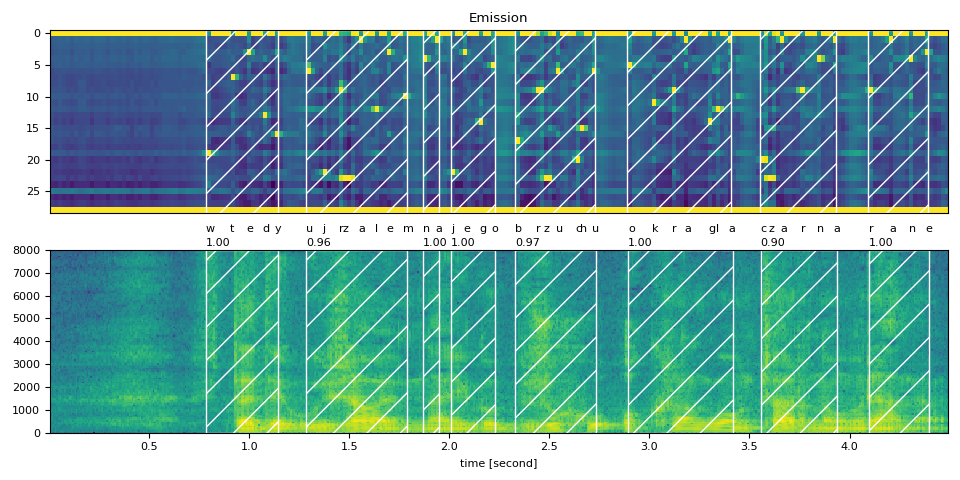
Raw Transcript: wtedy ujrzałem na jego brzuchu okrągłą czarną ranę
Normalized Transcript: wtedy ujrzalem na jego brzuchu okragla czarna rane
preview_word(waveform, token_spans[0], num_frames, transcript[0])
wtedy (1.00): 0.783 - 1.145 sec
preview_word(waveform, token_spans[1], num_frames, transcript[1])
ujrzalem (0.96): 1.286 - 1.788 sec
preview_word(waveform, token_spans[2], num_frames, transcript[2])
na (1.00): 1.868 - 1.949 sec
preview_word(waveform, token_spans[3], num_frames, transcript[3])
jego (1.00): 2.009 - 2.230 sec
preview_word(waveform, token_spans[4], num_frames, transcript[4])
brzuchu (0.97): 2.330 - 2.732 sec
preview_word(waveform, token_spans[5], num_frames, transcript[5])
okragla (1.00): 2.893 - 3.415 sec
preview_word(waveform, token_spans[6], num_frames, transcript[6])
czarna (0.90): 3.556 - 3.938 sec
preview_word(waveform, token_spans[7], num_frames, transcript[7])
rane (1.00): 4.098 - 4.399 sec
葡萄牙语¶
text_raw = "na imensa extensão onde se esconde o inconsciente imortal"
text_normalized = "na imensa extensao onde se esconde o inconsciente imortal"
url = "https://download.pytorch.org/torchaudio/tutorial-assets/6566_5323_000027.flac"
waveform, sample_rate = torchaudio.load(
url, frame_offset=int(bundle.sample_rate), num_frames=int(4.6 * bundle.sample_rate)
)
assert sample_rate == bundle.sample_rate
transcript = text_normalized.split()
emission, token_spans = compute_alignments(waveform, transcript)
num_frames = emission.size(1)
plot_alignments(waveform, token_spans, emission, transcript)
print("Raw Transcript: ", text_raw)
print("Normalized Transcript: ", text_normalized)
IPython.display.Audio(waveform, rate=sample_rate)
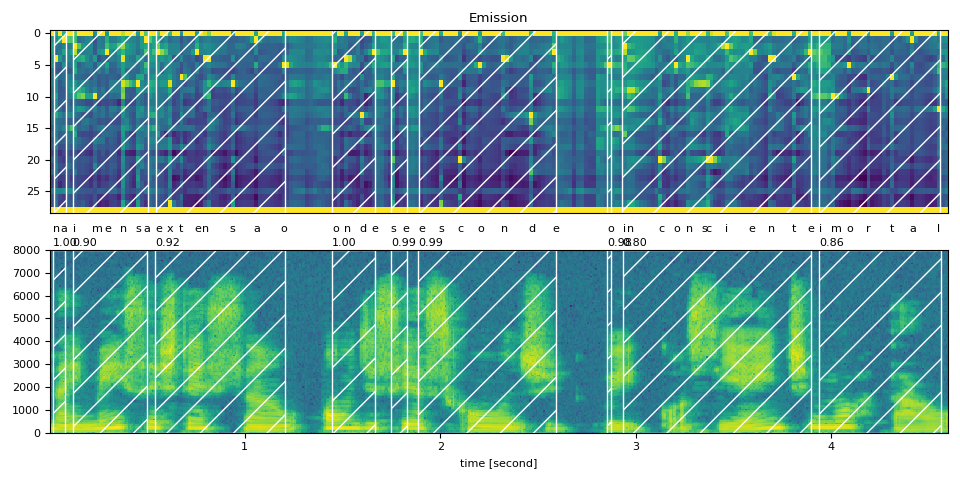
Raw Transcript: na imensa extensão onde se esconde o inconsciente imortal
Normalized Transcript: na imensa extensao onde se esconde o inconsciente imortal
preview_word(waveform, token_spans[0], num_frames, transcript[0])
na (1.00): 0.020 - 0.080 sec
preview_word(waveform, token_spans[1], num_frames, transcript[1])
imensa (0.90): 0.120 - 0.502 sec
preview_word(waveform, token_spans[2], num_frames, transcript[2])
extensao (0.92): 0.542 - 1.205 sec
preview_word(waveform, token_spans[3], num_frames, transcript[3])
onde (1.00): 1.446 - 1.667 sec
preview_word(waveform, token_spans[4], num_frames, transcript[4])
se (0.99): 1.748 - 1.828 sec
preview_word(waveform, token_spans[5], num_frames, transcript[5])
esconde (0.99): 1.888 - 2.591 sec
preview_word(waveform, token_spans[6], num_frames, transcript[6])
o (0.98): 2.852 - 2.872 sec
preview_word(waveform, token_spans[7], num_frames, transcript[7])
inconsciente (0.80): 2.933 - 3.897 sec
preview_word(waveform, token_spans[8], num_frames, transcript[8])
imortal (0.86): 3.937 - 4.560 sec
意大利语¶
text_raw = "elle giacean per terra tutte quante"
text_normalized = "elle giacean per terra tutte quante"
url = "https://download.pytorch.org/torchaudio/tutorial-assets/642_529_000025.flac"
waveform, sample_rate = torchaudio.load(url, num_frames=int(4 * bundle.sample_rate))
assert sample_rate == bundle.sample_rate
transcript = text_normalized.split()
emission, token_spans = compute_alignments(waveform, transcript)
num_frames = emission.size(1)
plot_alignments(waveform, token_spans, emission, transcript)
print("Raw Transcript: ", text_raw)
print("Normalized Transcript: ", text_normalized)
IPython.display.Audio(waveform, rate=sample_rate)
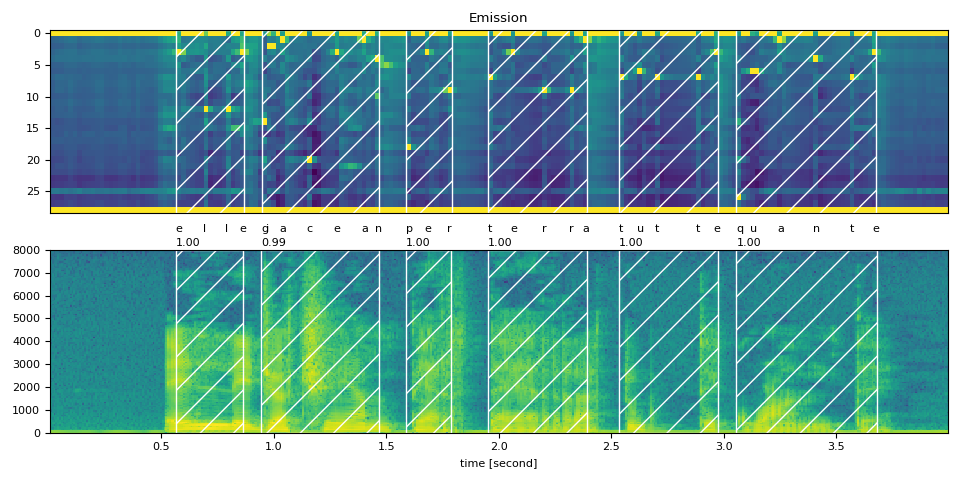
Raw Transcript: elle giacean per terra tutte quante
Normalized Transcript: elle giacean per terra tutte quante
preview_word(waveform, token_spans[0], num_frames, transcript[0])
elle (1.00): 0.563 - 0.864 sec
preview_word(waveform, token_spans[1], num_frames, transcript[1])
giacean (0.99): 0.945 - 1.467 sec
preview_word(waveform, token_spans[2], num_frames, transcript[2])
per (1.00): 1.588 - 1.789 sec
preview_word(waveform, token_spans[3], num_frames, transcript[3])
terra (1.00): 1.950 - 2.392 sec
preview_word(waveform, token_spans[4], num_frames, transcript[4])
tutte (1.00): 2.533 - 2.975 sec
preview_word(waveform, token_spans[5], num_frames, transcript[5])
quante (1.00): 3.055 - 3.678 sec
结论¶
在本教程中,我们了解了如何使用 torchaudio 的强制对齐 API 和 Wav2Vec2 预先训练的多语言声学模型进行对齐 语音数据转换为五种语言的转录内容。
确认¶
感谢 Vineel Pratap 和 Zhaoheng Ni 用于开发和开源 强制对准器 API。
脚本总运行时间:(0 分 4.092 秒)